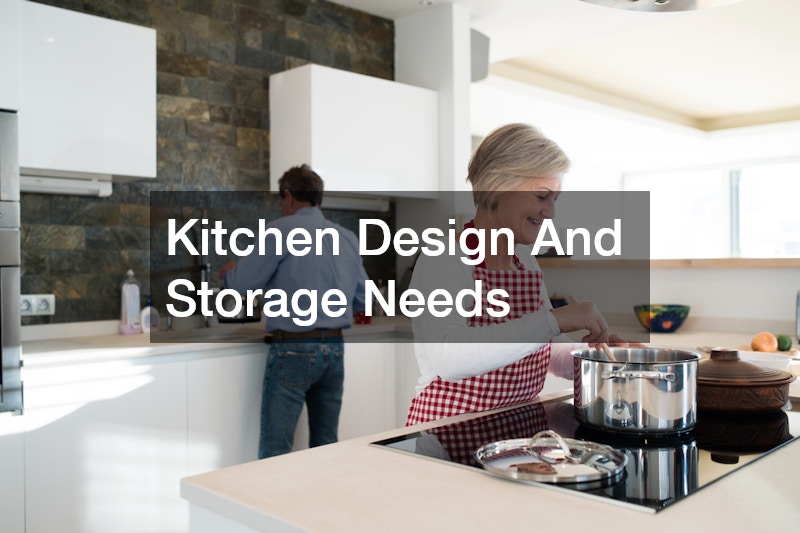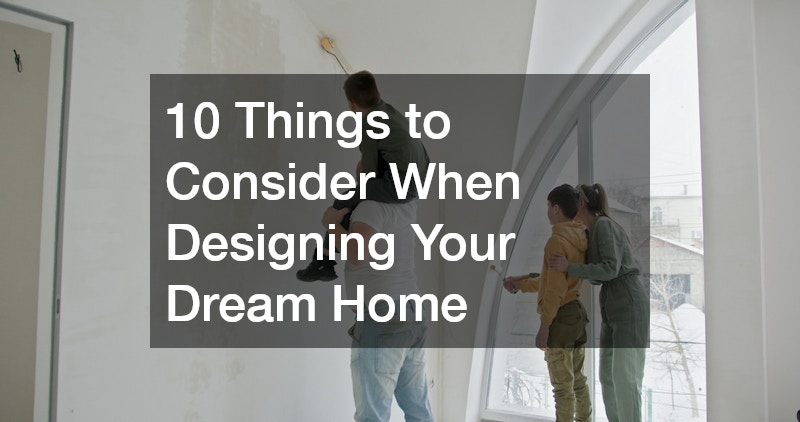Designing your dream home is one of the most exciting milestones in life, but it’s also a process that requires careful planning, thoughtful decision-making, and a clear vision of what you want your future living space to feel like. A custom home isn’t just a place to live — it’s an opportunity to create an environment that reflects your lifestyle, routines, priorities, and long-term goals. Whether you’re building for a growing family, designing your forever home, or simply crafting a space that feels uniquely your own, the choices you make early on will impact everything from comfort to energy efficiency to long-term maintenance needs.
Because a home build involves so many moving parts, it’s easy to overlook important considerations until it’s too late. That’s why taking the time to evaluate the structure, layout, style, and functionality of your home before breaking ground is essential. From choosing the right location to evaluating the work of roofing companies to selecting smart interior finishes, each decision plays a major role in how well your home will support the life you envision. This guide takes you through ten key areas you should consider during the design phase so your dream home becomes a space that truly enhances your everyday life.
Location And Lot Features

The land you choose for your dream home influences almost every major decision that follows — from structural design to landscaping potential to orientation of rooms. When evaluating a potential lot, consider factors like privacy, natural light, elevation, and existing vegetation. If the property includes large or overgrown trees, scheduling an evaluation with a tree service early in the planning process can help determine which trees can be preserved and which might pose a risk to the layout or the structure in the future.
Sun exposure is another critical element. The direction your home faces affects natural lighting, heating efficiency, and overall comfort. Many homeowners prefer south-facing living areas to capture more sunlight, while bedrooms positioned on the east side can take advantage of soft morning light. Additionally, think about the grade and drainage of the property. A lot with poor drainage may require extra work and potentially a consultation with local heavy equipment rental providers who can assist in grading or preparing the land properly before construction begins. These details may seem minor, but they play an important role in the long-term stability and livability of your home.
Architectural Style And Exterior Design
Your home’s exterior is the first impression and sets the tone for its overall character. Whether you’re drawn to modern minimalism, classic farmhouse aesthetics, Mediterranean influences, or a completely custom style, consistency in design is crucial for a cohesive final look. The architectural style you choose should also match the climate and environment where you’re building. Certain roof structures, siding materials, and window placements perform better in specific regions.
This is where it’s helpful to consult with experienced roofing companies early in the design process, as they can offer insights into which materials withstand weather conditions best in your area. Additionally, architectural style should balance aesthetics with practicality. Large windows may offer stunning views but can also impact energy efficiency, while elaborate rooflines may create visual appeal but require more maintenance over time. Taking the time to explore your options ensures your exterior design elevates both curb appeal and structural function.
Floor Plan And Traffic Flow
The interior layout of your home will greatly influence daily comfort and convenience. Before settling on a floor plan, think about how you live day to day. Households that entertain frequently may prefer an open-concept layout that allows easy movement from the kitchen to living areas. Those seeking quiet, private spaces may lean toward more segmented rooms with defined boundaries.
Traffic flow is equally important. You want to avoid bottlenecks near entrances, hallways that feel cramped, or awkward room transitions. Pay close attention to how people will enter the home, navigate hallways, and transition between key living zones. For example, placing the mudroom near the garage entrance allows for easier organization and reduces clutter. Similarly, designing a logical flow between the kitchen, pantry, and dining area makes mealtime easier. These small considerations help ensure your home supports the way you actually live, not just how it looks on a blueprint.
Kitchen Design And Storage Needs

The kitchen is often considered the heart of the home, and for good reason. It’s a place where the household gathers, meals are created, and memories are made. Because of its central role, your kitchen layout should be both beautiful and highly functional. Consider choosing kitchen cabinetry that maximizes storage without overwhelming the space. Custom cabinetry allows you to create a layout that fits your cooking habits, whether that means adding more drawers for utensils, specialized compartments for spices, or deep cabinets for appliances.
Countertop space is another essential element, as it supports food preparation, small appliances, and day-to-day use. Think about the placement of the sink, the distance between key work zones, and the overall flow of movement within the room. High-quality lighting also matters, including task lighting and ambient lighting that makes the kitchen more inviting. When each element harmonizes, the kitchen becomes a functional, comfortable place to spend time rather than a stressful or cramped work area.
Indoor–Outdoor Living Spaces
Modern home design frequently blurs the line between indoor and outdoor spaces, creating a seamless transition that extends living areas outward. Whether you enjoy relaxing outside, hosting gatherings, or simply appreciating natural surroundings, incorporating thoughtful outdoor design can elevate your lifestyle. One popular addition is a sunroom, which offers the benefits of natural light and outdoor views without exposing you to extreme temperatures or insects. A well-designed sunroom can serve as a reading nook, entertainment area, or cozy morning retreat.
Outdoor living areas can also include covered patios, outdoor kitchens, and entertainment zones. When designing these spaces, think about access from the home’s main rooms. For example, placing a patio adjacent to the living room or kitchen can make hosting guests easier and more enjoyable. Strategic landscaping also helps soften the transition between indoor and outdoor areas, making the entire property feel more unified and visually appealing.
Heating, Cooling, And Energy Efficiency
Climate control is a major factor in overall home comfort, and working with a knowledgeable HVAC contractor can help ensure your system is properly sized and energy efficient. Oversized or undersized systems can lead to higher energy bills, uneven temperature distribution, and unnecessary wear on the equipment. A contractor can help you evaluate options such as high-efficiency heat pumps, zoned heating and cooling, and programmable thermostats that give you more control over your home’s environment.
Beyond the HVAC system itself, the design of the home impacts energy efficiency. Window placement, insulation quality, roofing materials, and even room orientation can influence how comfortable your home feels throughout the year. Incorporating energy-saving features like high-performance windows, airtight construction, and upgraded insulation helps reduce long-term utility costs. Thoughtful design ensures you stay comfortable in every season without relying on excessive energy use.
Interior Lighting And Natural Light

Lighting plays a major role in mood, comfort, and functionality. A well-lit home feels warm and inviting, while poorly lit spaces can feel cramped, gloomy, or impractical. When planning your dream home, consider a combination of natural and artificial lighting. Natural light not only brightens your living areas but can also reduce energy consumption and improve emotional well-being. Larger windows, skylights, and open layouts help distribute sunlight more effectively throughout the home.
Artificial lighting should be carefully planned to include layers of illumination such as ambient, task, and accent lighting. Roller blind shades are helpful additions because they give you control over brightness and privacy while maintaining a clean, modern aesthetic. They allow you to soften harsh sunlight during midday hours yet still welcome natural light when you want it. A thoughtful lighting plan enhances every room’s atmosphere, making your home feel more comfortable and visually appealing.
Security, Technology, And Smart Features
As home technology advances, incorporating smart features into your design allows you to build a home that’s convenient, secure, and future-ready. Access control gate systems offer enhanced security by allowing you to monitor and control entry points from anywhere. These systems are especially beneficial for larger properties or homeowners who want additional layers of protection.
Beyond security, smart home features can simplify everyday tasks. Automated lighting, smart thermostats, video doorbells, integrated sound systems, and app-controlled appliances make your home more efficient and enjoyable. Planning these systems before construction ensures the necessary wiring and components are installed seamlessly rather than retrofitted later. This proactive approach saves time and money while giving your home modern functionality from the start.
Outdoor Design, Landscaping, And Privacy
The property surrounding your home is just as important as the structure itself. Well-planned landscaping enhances curb appeal, increases property value, and creates outdoor spaces that feel both welcoming and functional. Working with landscaping services during the design phase can help you develop a long-term plan that includes trees, flowerbeds, walkways, outdoor lighting, and irrigation systems. These elements not only add beauty but also improve privacy and shade throughout the property.
Privacy considerations should factor into your design as well. Trees, shrubs, and fencing can create peaceful backyard spaces where you can relax without feeling exposed. Outdoor lighting enhances safety and adds ambiance for evening gatherings. If you plan to include outdoor features such as fire pits or seating areas, consider how the surrounding landscape can support those spaces while maintaining harmony with the rest of the property.
Amenities, Recreation, And Long-Term Use

As you think about your dream home, consider how personal amenities can enhance your lifestyle. Features such as home gyms, hobby rooms, large garages, or expanded storage areas can significantly improve convenience and enjoyment. Many homeowners also dream of including recreational features that add comfort and entertainment value. For instance, some choose to work with pool builders to create a personalized backyard oasis. Whether you prefer a lap pool, a family-friendly layout, or a sophisticated modern design, integrating this feature early ensures proper planning for plumbing, electrical work, and outdoor aesthetics.
When adding amenities, think beyond current needs and consider how your lifestyle may evolve. Designing flexible spaces that can adapt to new hobbies, growing families, or aging-in-place needs helps future-proof your home so it continues supporting you for years to come. This long-term planning ensures your dream home remains functional, comfortable, and relevant as your life changes.
Designing your dream home is an opportunity to create a space that truly reflects who you are and how you want to live. Every detail — from the placement of windows to the flow of rooms to the outdoor spaces that surround your property — contributes to a home that feels personal and intuitive. By thoughtfully considering architecture, layout, energy efficiency, and design elements that match your lifestyle, you lay the foundation for a comfortable and long-lasting living environment.
Working with reputable professionals along the way, such as landscaping services, roofing companies, or even local heavy equipment rental providers during the early stages, ensures each step of the process is handled with expertise. Features like kitchen cabinetry, a sunroom, access control gate systems, roller blind shades, or recreational additions from trusted pool builders all work together to elevate your home’s overall experience.
Ultimately, the goal is not just to build a house but to create a space that brings joy, functionality, and long-term value. With thoughtful planning and the right partnerships, your dream home can become a place where comfort and creativity meet — a home designed with intention and built to support your life for decades to come.
As you move through the design process, take time to revisit your priorities and imagine how you’ll use each space on a daily basis. It’s easy to get caught up in visual details, but long-term comfort often comes from thoughtful choices like efficient layouts, durable materials, and flexible spaces that can adapt with time. Even small decisions — such as where natural light enters, how rooms connect, or how outdoor areas flow from the interior — can make a lasting difference in how grounded and at home you feel each day. With the right vision and careful planning, your dream home becomes a reality that grows with you.

